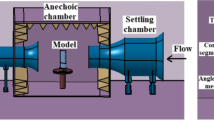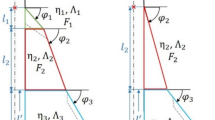Abstract
To improve the aerodynamic performance of tiltrotor aircraft, the flow characteristics of the V-22 airfoil without and with one, two parallel rows of vortex generators (VGs) were investigated using numerical simulation methods. The results were obtained with three-dimensional compressible Reynolds-averaged Navier–Stokes equations, and the turbulence was simulated with the SA-based DES model. The influence of the chordwise installation of VGs was emphatically discussed. First, the single-row VGs are, respectively, mounted at the 10, 20, and 40% chord positions, denoted as VGs1, VGs2, and VGs3. The results indicate that with the addition of the optimal configuration (VGs1), the maximum lift coefficient is extended from 1.43 to 2.44, and the stall angle of attack increases from 10° to 22° with respect to the clean airfoil. The drag coefficient of the airfoil with VGs1 is 60.8% lower than that of the airfoil without VGs at an angle of attack of 24°. On this basis, the double-row VGs’ arrangements are located at the 10 and 30% chord positions (VGs4), the 10 and 50% chord positions (VGs5) and the 10 and 70% chord positions (VGs6). Compared to single-row VGs, double-row VGs have the greater potential to suppress the flow separation. Due to the effect of VGs4, the maximum value of lift coefficient has increased to 2.61. However, the case of VGs6 degrades the overall aerodynamic performance as compared to VGs1. Further research suggest that with the increase in the height of the second row of vortex generators (VGs7), the aerodynamic characteristics of airfoil A821201 can be effectively enhanced at large angles of attack.















Similar content being viewed by others
Data Availability
The data used to support the findings of this study are available from the corresponding author upon request.
References
Alli P, Nannoni F, Cicale M (2003) Erica: the European tiltrotor design and critical technology projects. In:AIAA international air and space symposium and exposition: the next 100 years, p 2515, Dayton, Ohio, USA
Kelley CL, Corke TC, Thomas FO, Patel M, Cain AB (2016) Design and scaling of plasma streamwise vortex generators for flow separation control. AIAA J 54(11):3397–3408
Mueller-Vahl H, Pechlivanoglou G, Nayeri CN, Paschereit CO (2012) Vortex generators for wind turbine blades: a combined wind tunnel and wind turbine parametric study. In: ASME Turbo Expo 2012: turbine technical conference and exposition, p 69197, Copenhagen, Denmark
Fouatih OM, Medale M, Imine O, Imine B (2016) Design optimization of the aerodynamic passive flow control on NACA 4415 airfoil using vortex generators. Eur J Mech B/Fluids 56:82–96
Zhang L, Li XX, Yang K, Xue DY (2016) Effects of vortex generators on aerodynamic performance of thick wind turbine airfoils. J Wind Eng Ind Aerodyn 156:84–92
May NE (2001) A new vortex generator model for use in complex configuration CFD solvers. In: 19th AIAA applied aerodynamics conference, p 2434, Anaheim, California, USA
Yi JS, Kim C, Lee BJ (2012) Adjoint-based design optimization of vortex generator in an S-shaped subsonic inlet. AIAA J 50(11):2492–2507
Dudek JC (2011) Modeling vortex generators in a Navier-Stokes code. AIAA J 49(4):748–759
Jirasek A (2005) Vortex-generator model and its application to flow control. J Aircraft 42(6):1486–1491
Namura N, Shimoyama K, Obayashi S, Ito Y, Koike S, Nakakita K (2019) Multipoint design optimization of vortex generators on transonic swept wings. J Aircraft 56(4):1291–1302
Lee HM, Kwon OJ (2019) Numerical simulation of horizontal axis wind turbines with vortex generators. Int J Aeronaut Space Sci 20(2):325–334
Suarez JM, Flaszynski P, Doerffer P (2018) Application of rod vortex generators for flow separation reduction on wind turbine rotor. Wind Energy 21(11):1202–1215
Godard G, Stanislas M (2006) Control of a decelerating boundary layer. Part 1: optimization of passive vortex generators. Aerosp Sci Technol 10:181–191
Namura N, Jeong S (2013) Parametric study of vortex generators on a super critical infinite-wing to alleviate shock-induced separation. Trans Jpn Soc Aeronaut Space Sci 56(5):293–302
Tai TC (2003) Effect of midwing vortex generators on V-22 aircraft forward-flight aerodynamics. J Aircraft 40(4):623–630
Li XK, Yang K, Wang XD (2019) Experimental and numerical analysis of the effect of vortex generator height on vortex characteristics and airfoil aerodynamic performance. Energies 12(5):19
Bevan RLT, Poole DJ, Allen CB, Rendall TCS (2017) Adaptive surrogate-based optimization of vortex generators for a tiltrotor geometry. J Aircraft 54(3):1011–1024
Wang HP, Zhang B, Qiu QG, Xu X (2017) Flow control on the NREL S809 wind turbine airfoil using vortex generators. Energy 118:1210–1221
Zhu CY, Chen J, Wu JH, Wang TG (2019) Dynamic stall control of the wind turbine airfoil via single-row and double-row passive vortex generators. Energy 189:11
Huang W, Lu ZL, Guo TQ, Xue F, Zhang M (2012) Numerical method of static aeroelastic correction and jig-shape design for large airliners. Sci China Technol Sci 55(9):2447–2452
Jameson A, Schmidt W, Turkel E (1981) Numerical solution of the Euler equations by finite volume methods using Runge Kutta time stepping schemes. In: 14th AIAA fluid and plasma dynamic conference, p 1259, Palo Alto, California, USA
Yoon S, Jameson A (1988) Lower-upper Symmetric-Gauss-Seidel method for the Euler and Navier-Stokes equations. AIAA J 26(9):1025–1026
Spalart PR, Deck S, Shur ML, Squires KD, Strelets MKh, Travin A (2006) A new version of detached-eddy simulation, resistant to ambiguous grid densities. Theoret Comput Fluid Dyn 20(3):181–195
Namura N, Shimoyama K, Obayashi S (2015) Multipoint design of vortex generators on a swept infinite-wing under cruise and critical condition. In: 33rd AIAA applied aerodynamics conference, p 2726, Dallas, Texas, USA
Felker FF, Shinoda PR, Hefferman RM, Sheehy HF (1990) Wing force and surface pressure data from a hover test of a 0.658-scale V-22 rotor and wing, NASA Tech. Rep. 102244
Tai TC (1996) Simulation and analysis of V-22 tiltrotor aircraft forward-flight flowfield. J Aircraft 33(2):369–376
Baldacchino D, Manolesos M, Ferreira C et al (2016) Experimental benchmark and code validation for airfoils equipped with passive vortex generators. J Phys Conf Ser 753(2):022002
Baldacchino D, Ferreira C, Tavernier DD, Timmer WA, van Bussel GJW (2018) Experimental parameter study for passive vortex generators on a 30% thick airfoil. Wind Energy 21(9):745–765
Zhu CY, Wang TG, Wu JH (2019) Numerical investigation of passive vortex generators on a wind turbine airfoil undergoing pitch oscillations. Energies 12(4):15
Acknowledgements
This work was supported by the Scientific Research Foundation of Huaiyin Institute of Technology (no. Z301B19511).
Author information
Authors and Affiliations
Corresponding author
Ethics declarations
Conflicts of Interest
The authors declare that there is no conflict of interest regarding the publication of this paper.
Additional information
Publisher's Note
Springer Nature remains neutral with regard to jurisdictional claims in published maps and institutional affiliations.
Rights and permissions
About this article
Cite this article
Chen, H., Chen, B. Aerodynamic Performance Enhancement of Tiltrotor Aircraft Wings Using Double-Row Vortex Generators. Int. J. Aeronaut. Space Sci. 22, 802–812 (2021). https://doi.org/10.1007/s42405-020-00346-8
Received:
Revised:
Accepted:
Published:
Issue Date:
DOI: https://doi.org/10.1007/s42405-020-00346-8




